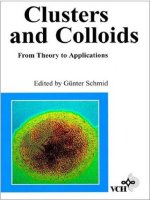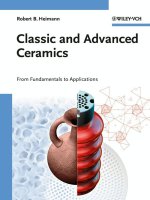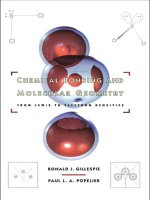classic and advanced ceramics - from fundamentals to applications
Bạn đang xem bản rút gọn của tài liệu. Xem và tải ngay bản đầy đủ của tài liệu tại đây (13.4 MB, 576 trang )
Robert B. Heimann
Classic and Advanced Ceramics
From Fundamentals to Applications
Robert B. Heimann
Classic and Advanced
Ceramics
Related Titles
Aldinger, F., Weberruss, V. A.
Advanced Ceramics and
Future Materials
An Introduction to Structures, Properties
and Technologies
2010
Hardcover
ISBN: 978-3-527-32157-5
Riedel, R., Chen, I-W. (eds.)
Ceramics Science and
Technology
4 Volume Set
Hardcover
ISBN: 978-3-527-31149-1
Volume 1: Structures
2008
Hardcover
ISBN: 978-3-527-31155-2
Volume 2: Properties
2010
Hardcover
ISBN: 978-3-527-31156-9
Volume 3: Synthesis and Processing
2010
Hardcover
ISBN: 978-3-527-31157-6
Volume 4: Applications
2012
Hardcover
ISBN: 978-3-527-31158-3
Öchsner, A., Ahmed, W. (eds.)
Biomechanics of Hard Tissues
Modeling, Testing, and Materials
2010
Hardcover
ISBN: 978-3-527-32431-6
Krenkel, W. (ed.)
Ceramic Matrix Composites
Fiber Reinforced Ceramics and their
Applications
2008
Hardcover
ISBN: 978-3-527-31361-7
Öchsner, A., Murch, G. E.,
de Lemos, M. J. S. (eds.)
Cellular and Porous Materials
Thermal Properties Simulation and Prediction
2008
Hardcover
ISBN: 978-3-527-31938-1
Robert B. Heimann
Classic and Advanced Ceramics
From Fundamentals to Applications
All books published by Wiley-VCH are carefully
produced. Nevertheless, authors, editors, and
publisher do not warrant the information
contained in these books, including this book, to
be free of errors. Readers are advised to keep in
mind that statements, data, illustrations,
procedural details or other items may
inadvertently be inaccurate.
Library of Congress Card No.: applied for
British Library Cataloguing-in-Publication Data
A catalogue record for this book is available from
the British Library.
Bibliographic information published by the
Deutsche Nationalbibliothek
The Deutsche Nationalbibliothek lists this
publication in the Deutsche Nationalbibliografi e;
detailed bibliographic data are available on the
Internet at .
© 2010 WILEY-VCH Verlag GmbH & Co.
KGaA, Weinheim
All rights reserved (including those of translation
into other languages). No part of this book may
be reproduced in any form – by photoprinting,
microfi lm, or any other means – nor transmitted
or translated into a machine language without
written permission from the publishers.
Registered names, trademarks, etc. used in this
book, even when not specifi cally marked as such,
are not to be considered unprotected by law.
Cover Design Formgeber, Eppelheim
Typesetting Toppan Best-set Premedia Limited
Printing and Binding Betz-Druck GmbH,
Darmstadt
Printed in the Federal Republic of Germany
Printed on acid-free paper
ISBN: 978-3-527-32517-7
The Author
Prof. Dr. Robert B. Heimann
Am Stadtpark 2A
02826 Görlitz
V
To Gabriele whose love, support, and patience were indispensable for creating this text.
Classic and Advanced Ceramics: From Fundamentals to Applications. Robert B. Heimann
© 2010 WILEY-VCH Verlag GmbH & Co. KGaA, Weinheim
ISBN: 978-3-527-32517-7
VII
Classic and Advanced Ceramics: From Fundamentals to Applications. Robert B. Heimann
© 2010 WILEY-VCH Verlag GmbH & Co. KGaA, Weinheim
ISBN: 978-3-527-32517-7
Contents
Preface XV
1 Introduction to Classic Ceramics 1
1.1 Ceramics through the Ages, and Technological Progress 1
1.2 Classifi cation of Ceramics 6
References 9
2 Mineralogy, Structure, and Green Processing of Clay Minerals 11
2.1 Natural Clay Minerals 12
2.1.1 Formation of Clay Minerals 13
2.1.2 Structure of Important Clay Minerals 16
2.1.2.1 Kaolinite 18
2.1.2.2 Illite 19
2.1.2.3 Montmorillonite: Structure and Application 22
2.1.3 Nomenclature of Clays 26
2.2 Synthetic Raw Materials 27
2.3 Processing and Forming of Clay Powders 30
2.3.1 Dry Forming Methods 31
2.3.2 Wet Forming Methods 31
2.4 Rheology of Clay Particle Suspensions 32
2.4.1 Modeling of Rheological Behavior 32
2.4.1.1 Linear Two-Element Models 34
2.4.1.2 Linear Three-Element Models 36
2.4.1.3 Nonlinear Models 37
2.4.2 Colloidal Processing of Clay 37
2.4.2.1 Structural Viscosity 37
2.4.2.2 Hofmeister Series 40
2.4.2.3 Effect of pH on Clay–Water Suspensions 41
2.4.2.4 Zeta (Electrokinetic) Potential 42
2.4.2.5 Thixotropy and Rheopexy 46
2.5 Drying of Green Clay Bodies 47
References 50
VIII Contents
3 Important Ceramic Phase Systems 55
3.1 Fundamentals of Phase Diagrams 55
3.1.1 Gibbs’ Phase Rule 55
3.1.2 One-Component Phase Diagrams 57
3.1.3 Two-Component (Binary) Phase Diagrams 59
3.1.3.1 Simple Binary Phase Diagram without Intermediate Compound
or Solid Solution 59
3.1.3.2 Complete Solid Solution of Two Components 61
3.1.4 Three-Component (Ternary) Phase Diagrams 62
3.1.4.1 Composition of a Ternary Compound 62
3.1.4.2 Phase Boundary Lines, Eutectic Points, and Degrees of Freedom 63
3.1.4.3 Compatibility Joins (Conodes) and Compatibility Triangles 64
3.1.4.4 The Complete (3-D) Ternary Phase Diagram 65
3.1.5 Four-Component (Quaternary) Phase Diagrams 68
3.1.5.1 Conclusion 70
3.2 Phase Systems with Ceramic Relevance 71
3.2.1 One-Component Systems 71
3.2.1.1 Silica 71
3.2.2 Two-Component Systems 81
3.2.2.1 Al
2
O
3
–SiO
2
81
3.2.2.2 MgO–SiO
2
84
3.2.2.3 CaO–SiO
2
86
3.2.3 Three-Component Systems 88
3.2.3.1 CaO–Al
2
O
3
–SiO
2
88
3.2.3.2 K
2
O–Al
2
O
3
–SiO
2
89
References 94
4 Mineralogy and Chemistry of the Ceramic Firing Process 99
4.1 Introduction 99
4.2 Crystallography of the Thermal Transformation of Kaolinite 100
4.3 Thermal Transformations in Illitic Clays 104
4.4 Thermal Transformations and Phase Formation in the System
MgO–CaO–Al
2
O
3
–SiO
2
109
4.5 Thermal Transformations and Phase Formation in the System
MgO–(Fe
2
O
3
)–Al
2
O
3
–SiO
2
113
References 117
5 Mineralogy and Chemistry of Cements 119
5.1 Historical Development 119
5.2 Portland Cement 120
5.2.1 Introduction 120
5.2.2 Typical Composition and Materials Properties 121
5.2.3 Phase Composition 124
5.2.4 Hydration of Clinker Minerals 128
5.2.4.1 Calcium Silicates 128
Contents IX
5.2.4.2 Calcium Aluminate 129
5.2.4.3 Ferrite (Brownmillerite) 131
5.2.4.4 Kinetics of Hydration 132
5.2.5 Models of Hydration 133
5.2.5.1 Delayed Nucleation Model 133
5.2.5.2 Protective Layer Model 134
5.2.6 Setting and Hardening of Cement 136
5.3 High-Performance Concretes (HPC) 138
5.3.1 Mineral and Chemical Admixtures 138
5.3.1.1 Mineral Admixtures 138
5.3.1.2 Chemical Admixtures 139
5.3.2 DSP Cement 142
5.3.3 Macro-Defect-Free (MDF) Cement 143
5.3.4 Gas Concrete (Autoclaved Aerated Concrete; AAC) 144
5.4 Environmental Impact and Concrete Recycling 145
5.4.1 CO
2
Emissions 146
5.4.2 NO
x
Emissions 146
5.4.3 Particulate Emissions and Visual Pollution 147
5.4.4 Water Pollution 147
5.4.5 Environmental Benefi ts 148
5.5 Future Developments and Outlook 150
5.5.1 Reduction of the Emission of Greenhouse Gases 150
5.5.2 Recycling of Concrete 151
References 153
6 Introduction to Advanced Ceramics 157
6.1 General Properties of Advanced Ceramics 157
6.2 The Current World Market Situation 163
6.2.1 Advanced Structural Ceramics 164
6.2.2 Advanced Electronic Ceramics 164
6.2.3 Advanced Ceramic Coatings 166
6.2.4 Chemical Processing and Environment-Related Ceramics 167
6.2.5 Bioceramics, Bioactive Glasses, and Coatings 168
6.3 Recent US and Global Forecasts 168
6.3.1 Advanced Ceramic Powders 170
6.3.2 Carbon Nanotubes 171
6.3.3 Ceramic Superconductors 171
References 172
7 Oxide Ceramics: Structure, Technology, and Applications 175
7.1 Alumina 175
7.1.1 General Properties and Application 175
7.1.2 Processing of Alumina 176
7.1.2.1 Extraction 176
7.1.2.2 Precipitation 177
X Contents
7.1.2.3 Calcination 178
7.1.3 Structure of Alumina Polymorphs 178
7.1.3.1 Stable Alumina Polymorphs 178
7.1.3.2 Transitional Alumina Polymorphs 182
7.1.4 Specifi c Properties and Applications 185
7.1.4.1 Duplex Al
2
O
3
–ZrO
2
Ceramics 185
7.1.4.2 Stuffed Alumina Ceramics 185
7.1.4.3 Selected Applications of Alumina Ceramics 186
7.2 Zirconia 196
7.2.1 Introduction 196
7.2.2 Processing of Zirconia 197
7.2.3 Structure of Zirconia 199
7.2.4 Transformation Toughening of Zirconia Ceramics 201
7.2.5 Binary Phase Systems 208
7.2.5.1 System ZrO
2
–MgO 208
7.2.5.2 System ZrO
2
–CaO 208
7.2.5.3 System ZrO
2
–Y
2
O
3
208
7.2.5.4 System ZrO
2
–CeO
2
211
7.2.5.5 System ZrO
2
–Sc
2
O
3
213
7.2.6 Selected Applications of Zirconia 215
7.2.6.1 Structural Applications 215
7.2.6.2 Functional Applications 219
7.3 Titania 235
7.3.1 General Properties and Applications 235
7.3.2 Processing of Titania 235
7.3.3 Structure of Titania 237
7.3.4 Selected Applications 238
7.3.4.1 Pigments 238
7.3.4.2 Semiconductor Gas Sensors 239
7.3.4.3 Photocatalysis 240
7.3.4.4 Antimicrobial Coatings 243
7.3.4.5 Photovoltaic Applications 243
References 245
8 Electroceramic Materials 253
8.1 Introduction 253
8.1.1 Defi nition and Properties of Ferroic, Smart, and Intelligent
Materials 254
8.1.2 Historical Development of Dielectric Ceramics 256
8.2 Physics of Dielectric Materials 258
8.2.1 Dielectric Effects 258
8.2.2 Electric Polarization in Dielectric Materials 259
8.2.3 Characteristic Dielectric Parameters 267
8.3 Ferroelectric Ceramics 269
8.3.1 Barium Titanate (BT) 273
Contents XI
8.3.2 Lead Zirconate/Lead Titanate (PZT) 275
8.3.3 Ferroelectric Relaxor Ceramics 277
8.4 Microwave Ceramics 281
8.4.1 Grain Boundary Engineering 281
8.4.2 Design of Microwave Ceramics 283
8.5 Pyroelectric and Piezoelectric Ceramics 288
8.5.1 Pyroelectric Ceramics 289
8.5.2 Semiquantitative Model of Piezoelectricity 291
8.5.3 Novel Piezoelectric Single Crystals with CGG Structure 294
8.5.3.1 Structure of CGG Compounds 295
8.5.3.2 Czochralski Growth of Single Crystals 296
8.5.3.3 Selected Properties of Single Crystals with CGG Structure 297
8.6 Electro-Optic Ceramics 301
8.6.1 Linear Electro-Optic (Pockels) Effect 301
8.6.2 Quadratic Electro-Optic (Kerr) Effect 302
8.6.3 Electro-Optic Constants of Piezoelectric Single Crystals of
CGG-Type 303
8.6.4 Electro-Optic Lead Lanthanum Zirconate Titanate (PLZT) 303
8.7 Selected Applications of Electroceramic Materials and Devices 304
8.7.1 Microwave Resonators 304
8.7.1.1 Types and Characteristics of Resonators 305
8.7.2 Examples of Applications of Ferroelectric Ceramic Materials 307
8.7.3 Examples of Applications of Piezoelectric Ceramic Materials 308
8.7.4 Reliability of Devices 311
References 312
9 Superconducting Ceramics 319
9.1 Introduction 319
9.2 Defi nitions 319
9.3 Historical Developments 320
9.4 Material Classifi cation 323
9.5 Crystal Chemistry 324
9.5.1 Nb-Bearing Low-Temperature Superconductors 324
9.5.2 Superconducting MgB
2
324
9.5.3 Iron Pnictides 325
9.5.4 Cuprate Superconductors 326
9.6 Theory 331
9.7 Materials Processing 331
9.7.1 Nb
3
Sn Fabrication Processes 332
9.7.2 MgB
2
Fabrication Process 333
9.7.3 Processing of HTS Cuprates 333
9.7.3.1 Bulk Material and Tapes from YBCO 334
9.7.3.2 BSCCO Wires and Tapes 335
9.8 Applications of Ceramic Superconductors 336
9.8.1 Cables for Power Grids 336
XII Contents
9.8.2 Superconducting Magnets 339
9.8.3 Magnetic Levitation and Combined Bearings 340
9.8.4 Superconducting Magnetic Energy Storage (SMES) 340
9.8.5 Magnetic Shielding 341
9.8.6 Electronic Applications 341
9.9 Outlook and Future Developments 342
References 343
10 Bioceramic Materials 347
10.1 Introduction 347
10.1.1 Scope and Socioeconomic Consequences 347
10.1.2 Basic Aspects of Biomineralization 348
10.1.3 Design of Endoprosthetic Implants 349
10.2 The Concept and Defi nition of Biocompatibility 352
10.3 The Interaction of Implant Materials and Living Tissues: A Basic
Approach 354
10.4 Mechanical Properties of Advanced Bioceramics: Alumina versus
Zirconia 357
10.5 Selected Bioceramic Materials 359
10.5.1 Bioinert Ceramics 359
10.5.1.1 Alumina 359
10.5.1.2 Y-Stabilized Zirconia (Y-TZP) 361
10.5.2 Bioconductive Ceramics 365
10.5.2.1 Bioglasses 365
10.5.2.2 Hydroxyapatite 369
10.5.2.3 Calcium–Titanium–Zirconium Phosphates 382
10.5.2.4 Resorbable Calcium Phosphate Ceramics 393
10.6 Performance Requirements and Quality Control of Ceramic Femoral
Ball Heads 396
10.6.1 Electronic Processes during γ-Ray Sterilization of Zirconia Femoral
Heads 400
10.7 Future Developments and Outlook 405
References 408
11 Non-Oxide Ceramics: Structure, Technology, and Applications 421
11.1 Introduction 421
11.2 Carbides 424
11.2.1 Boron Carbide 425
11.2.1.1 General Properties and Applications 425
11.2.1.2 Processing of Boron Carbide 425
11.2.1.3 Structure and Bonding of Boron Carbide 426
11.2.1.4 Selected Applications of Boron Carbide 427
11.2.2 Silicon Carbide 429
11.2.2.1 General Properties and Applications 429
11.2.2.2 Processing of Silicon Carbide 430
Contents XIII
11.2.2.3 Structure of Silicon Carbide 435
11.2.2.4 Selected Applications of Silicon Carbide 436
11.3 Nitrides 442
11.3.1 Boron Nitride 442
11.3.1.1 General Properties and Applications 442
11.3.1.2 Synthesis and Processing of Boron Nitride 443
11.3.1.3 Structure of Boron Nitride 445
11.3.1.4 Selected Applications of Boron Nitride 447
11.3.2 Aluminum Nitride 452
11.3.2.1 General Properties and Applications 452
11.3.2.2 Synthesis and Processing of Aluminum Nitride 452
11.3.2.3 Structure of Aluminum Nitride 453
11.3.2.4 Selected Applications of Aluminum Nitride 454
11.3.3 Silicon Nitride 457
11.3.3.1 General Properties and Applications 457
11.3.3.2 Synthesis and Processing of Silicon Nitride 458
11.3.3.3 Structure of Silicon Nitride 463
11.3.3.4 Selected Applications of Silicon Nitride 465
11.3.4 SiAlONs 468
11.3.4.1 General Properties and Applications of Sialons 468
11.3.4.2 Synthesis and Processing of Sialons 468
11.3.4.3 Structure of Sialons 470
11.3.4.4 Selected Applications of Sialons 472
References 474
12 Advanced Ceramic Processing and Future Development Trends 481
12.1 Design of Monodisperse Ceramic Powders 481
12.2 Ceramic Processing in a Microgravity Environment 482
12.3 Powder Preparation under Reduced Gravity 483
12.4 Ceramic Powder Synthesis by SHS 487
12.5 Nanosized Ceramic Powders 488
12.5.1 Unique Properties of Nanoparticles 488
12.5.2 Application of Ceramic Nanopowders 490
12.5.3 The Manufacture of Nanopowders 492
12.5.4 Structural Characterization of Ceramic Nanoparticles 493
12.6 Future Development Trends 494
References 496
Appendices 499
Appendix A Construction of the Phase Diagram of a Binary System A–B with
Ideal Solid Solution 501
Appendix B Thermodynamics of Displacive Phase Transitions 507
Displacive Transition in Crystals with Perovskite Structure 507
XIV Contents
Landau Theory 508
Application of the Landau Theory to Ferroelectric
Transitions 511
References 513
Appendix C Radial Electron Density Distribution (RED) Function 515
References 520
Appendix D Thermodynamics of Spinodal Decomposition of Crystals 521
References 524
Appendix E Theory of Superconductivity 525
London Equations 525
Bardeen–Cooper–Schrieffer (BCS) Theory 526
High-Temperature Superconductor (HTS) Cuprates
(Unconventional Superconductors) 528
Heavy Fermion Superconductors 533
Type II Superconductors 534
References 535
Index 537
Modern materials science and engineering technology rely on the three principal
classes of material, distinguished by their nature of chemical bonding: metals;
ceramics and polymers; and the alloys and composites of these materials. The aim
of this treatise is to educate not only graduate and doctoral students but also pro-
fessionals in mineralogy, chemistry, materials science and related disciplines on
the subject of ceramics, both traditional and advanced. Hopefully, it will also serve
as a primer for more involved studies in ceramic engineering proper , and thus lay
the foundation for a more detailed knowledge acquisition.
Ceramics , by defi nition, are inorganic, nonmetallic and predominantly polycrys-
talline materials that may be shaped at room temperature from a variety of raw
materials. They obtain their typical properties by sintering at high temperatures.
Unlike the German custom of distinguishing between inorganic (poly)crystalline
(ceramics sensu strictu ) and noncrystalline (glasses) materials, the English usage
includes glasses in the generic term “ ceramics. ” However, in this treatise the
author will follow the German tradition, and consequently glasses and other
amorphous materials will be excluded from the discussions. Nonetheless, silicate -
based chemically bonded ceramic s ( CBC s) such as cements/concrete will be
included as, with time, they undergo crystallization processes.
Ceramics are the oldest man - made materials, dating back to the dawn of human
civilization. They possess an overwhelmingly wide variability in terms of their
origin, history, utilization, and mechanical, thermal, optical, biological and elec-
tronic properties. Traditional ceramics are based almost exclusively on naturally
occurring raw materials, most commonly silicaceous minerals such as clays,
micas, quartz and feldspars, although for special applications synthetically pro-
duced clay minerals may also be utilized. A smattering of other nonsilicate miner-
als may also be included, such as gibbsite, magnesite, calcite, and dolomite. In
contrast to this, advanced ceramics are produced predominantly from chemically
synthesized micro - or nanoscaled pure alumina, titania, zirconia, magnesia and
other oxides and their compounds, as well as from the carbides and nitrides of
silicon, boron and aluminum, and a host of transitional elements. The processing
technologies used include the high - temperature transformation of raw materials
into desired ceramic bodies, with highly controlled mechanical, thermal, electrical,
tribological and optical properties, in addition to the low - temperature hydrolysis
XV
Preface
Classic and Advanced Ceramics: From Fundamentals to Applications. Robert B. Heimann
© 2010 WILEY-VCH Verlag GmbH & Co. KGaA, Weinheim
ISBN: 978-3-527-32517-7
XVI Preface
of calcium silicates and aluminates to synthesize CBCs such as concrete. Hence,
the application of ceramics spans the chasm between traditional silicate - based
structural materials such as bricks, earthenware, stoneware, porcelain and con-
crete, and “ high - tech ” functionally advanced ceramics such as thermal barrier
coatings for aerospace gas turbine blades, electrolyte layers for high - temperature
solid oxide fuel cells, ferroic ceramics for sensor and actuator applications,
diamond single crystals for future carbon - based integrated circuits, and biocon-
ductive monolithic parts and coatings for bone reconstruction and dental and
endoprosthetic hip implants.
The aim of this book is to cover pertinent aspects of the processing, structure,
technology and properties of classic and advanced ceramic materials, but without
claiming to exhaust the topic even remotely in an encyclopedic fashion. Instead,
typical examples will be described that stand pars pro toto for the totality of ceramic
materials in existence today. Consequently, special emphasis is placed on the
mineralogy of the materials described, the basic crystallographic aspects of the
thermal transformation processes during the fi ring of natural ceramic raw materi-
als to arrive at traditional structural ceramics, as well as on the general physical
principles of functionally advanced ceramics such as zirconia or silicon nitride,
the technically important class of ferroic and superconducting ceramic materials
on which many modern “ high - tech ” applications such as sensors and actuators
are based, and last – but not least – bioceramics to replace diseased bone and restore
lost functions of the human body.
The plethora of excellent books on ceramics produced during the past thirty
years have been devoted predominantly to either the fundamentals, to the process
technology, or to the engineering applications of their subject matter, while paying
considerably less attention to other subjects. Likewise, books on advanced ceram-
ics are generally replete with highly complex solid - state physics that do not always
match the level of interest, let alone the comprehension of their intended audience,
from areas of mineralogy, chemistry, and materials engineering. Instead, the
present book attempts to take a “ middle road ” between process engineering and
solid - state physics approaches by providing a technical (applied) mineralogy
approach. The intention is, therefore, to bridge the perceived abyss between the
more deductively oriented realm of physics, chemistry and materials science, and
the more inductively and empirically oriented realm of the geosciences. As inher-
ent in the role of technical mineralogy, this different approach will combine – in a
synergistic manner – the viewpoints and expertise of geosciences and materials
science, and will therefore fi nd its main audience among graduate and doctoral
students and professionals of mineralogy that, in this context, can be defi ned as
“ the materials science of the solid earth. ”
The text is largely based on a series of lectures given to graduate students of
geosciences at Technische Universit ä t Bergakademie Freiberg between 1993 and
2004, to undergraduate and graduate students of physics and chemistry at Chiang
Mai University, Chiang Mai, Thailand, and to graduate students of materials
science at Chulalongkorn University, Bangkok, Thailand between 1998 and 2001.
The subject matter of ceramics – and in particular of advanced ceramics – is a lively
Preface XVII
area of research and development endeavor, with several thousands of reports
made annually among a host of scientifi c and trade journals. It would be futile to
attempt to cover even a small fraction of this trove of information in a single book;
hence, what is provided in the following pages is a mere “ snapshot ” of past and
ongoing developments – no more, no less.
Since in the previous paragraphs the viewpoints of technical (applied) mineral-
ogy have been invoked, a general paradigmatic positioning of this specifi c disci-
pline should be appended here. Research, development and teaching in the fi eld
of technical mineralogy provide a modern, tractable bridge between the classical
geosciences and modern materials science. Technical (applied) mineralogy can be
defi ned as that discipline of “ mineralogical sciences ” that studies the mineralogical
structure and properties, the technological fundamentals, and the characterization
of raw materials, technical products and processes that include the mineralogy of
residual and waste product streams, and pertinent environmental issues. Hence,
it is positioned at all crossroads of the “ modern materials cycle ” (Figure P.1 ). In
particular, it assists in the enhancement of traditional materials, and in the devel-
opment of novel advanced materials.
The arena of activities of technical mineralogists in academia, government, and
industry is extremely diverse and includes, but is not limited to:
• The benefi ciation of raw materials (ore, industrial minerals, coal, salts, stone,
clay).
• The design, development, synthesis, processing, testing and quality manage-
ment of technical products (ceramics per se , glass, cement, construction materi-
als, pigments), including single crystal growth and mass crystallization as well
as their characterization with polarization microscopy and X - rays, but also
increasingly modern high - resolution analytical surface techniques.
• The control, remediation, and risk analysis of historical and modern tailings
of mining, and ore dressing and smelting activities, as well as the development
and validation of environmentally safe materials for sound disposal concepts
of domestic and industrial wastes, including radioactive matter.
• Environmental activities to foster a sustainable raw materials and energy
economy, including the management of minerals that occur as secondary
products of industrial processes, such as gypsum derived from fl ue gas desul-
furization , and other residual and waste materials.
• Damage analysis and the restoration of ancient monuments, as well as the
determination of provenance, age, type of material, and manufacturing tech-
nologies of historical objects of art (archaeometry).
This wide professional range attesting to the heterogeneity of the discipline
creates lively interdisciplinary collaboration among neighboring fi elds of scientifi c
and engineering endeavors. These fi elds include solid - state chemistry and physics,
materials technology and engineering, process engineering, mining, geology
and geophysics, geoecology, biology, medicine, environmental sciences, as well
XVIII Preface
as archeology and social and cultural sciences. Hence, the curriculum of technical
(applied) mineralogy is both versatile and involved. As opposed to chemistry
or mechanical engineering, the lack of an industry that directly mirrors the scope
of academic research within technical mineralogy somewhat impedes any fruitful
research interaction with colleagues in industry. Yet, whilst the variability of
the fi elds of endeavor of technical mineralogy and increasing cross - pollination
among neighboring disciplines preclude a clear distinction of responsibilities,
the old adage still applies: “ Technical mineralogy is what technical mineralogists
do. ”
I am highly indebted to Prof. Dr Dr.h.c. Walter Heywang (M ü nchen), Prof.
Horst J. Pentinghaus (Karlsruhe), Prof. Herbert P ö llmann (Halle) and Dipl. - Phys.
Wolfram Wersing (Bergen, Chiemgau) for providing advice and valuable critical
Figure P.1 The domain of technical
mineralogy within the materials cycle. During
all operations, from mining to the production
of raw and refi ned materials to the manufac-
ture of end products and to their eventual
disposal and/or recycling, several waste
material streams are created that challenge
R & D in technical (applied) mineralogy. The
sizes of the circles symbolize the different
relative volumina of the mass streams,
whereby the contribution of the Earth ’ s crust
is grossly underrepresented.
MATERIALS SCIENCE AND ENGINEERING
Extracting,
refining
Materials
Processing
Wastes
Wastes
Wastes
Earth’s crust
Domain
of
Technical
Mineralogy
Raw
Materials
Domain
of
Technical
Sciences
Mining, quarrying,
collecting, drilling
Wastes
Set of manufacturing
processes
Final
product
Loss of useful
function
Used-up
materials
ENVIRONMENTAL SCIENCES AND GEOECOLOGY
Clean wastes
Recycling
Disposal
GEOSCIENCES AND MINING
MECHANICAL ENGINEERING
Secondary
Materials
Domain
of
Natural
Sciences
Refined
Materials
Preface XIX
comments, and, in particular, to Prof. Hans Hermann Otto (Clausthal - Zellerfeld)
for contributing Chapter 9 and Appendix E . The publishing house Wiley - VCH
Weinheim, represented by Dr Heike N ö the, lent important editorial and logistic
support.
Robert B. Heimann
G ö rlitz
Introduction to Classic Ceramics
1.1
Ceramics through the Ages, and Technological Progress
Throughout the ages of humankind, materials have been the overwhelmingly
crucial determinant of the competitiveness of individuals and societies. Today, a
better understanding of the atomic and molecular structure of materials is becom-
ing indispensable for the development of new materials, and the improvement of
existing materials. As a result, materials are being tailored to meet specifi c applica-
tions to address pressing industrial and societal challenges in the highly competi-
tive contemporary world. In this process, ceramics technology plays a particularly
important role, and hence has emerged as a driver of technological progress in
many industrial sectors.
It is a widely accepted paradigm that such technological progress takes place
in a highly competitive environment where only a limited amount of the required
resources exist. Hunger for raw materials has always been a strong driving force
in world history. Throughout the history of humankind, the information con-
tained within each newly developed or signifi cantly improved material or technol-
ogy has increased exponentially. Figure 1.1 suggests that the knowledge required
to make pottery – that is, the mining/collecting, processing, forming, and fi ring
of clay, including the knowledge and skill to construct and operate kilns and
fl ues – were orders of magnitude higher than those needed to fashion rather
simple tools and implements from bone or stone. The quantifi cation of the “ tech-
nology information content, ” plotted logarithmically on the ordinate of Figure
1.1 , is – of course – highly subjective. Nevertheless, it suggests that the knowledge
acquired in pottery making has later been put to use to mine, dress, and smelt
ore, and to purify and alloy metals. As is evident from the fi gure, technological
development stagnated in the Western societies during the Dark and Middle ages,
but eventually took off dramatically during the Renaissance and the emerging
Age of Science. Since the rate of change in materials technology is ever -
accelerating, the increase in information content – that is, entropy – leads to an
ever - decreasing technological half - life of newly invented materials and tech-
nologies. The consequences of this effect have been estimated and projected
onto future economical and societal trends of developed and developing nations
1
1
Classic and Advanced Ceramics: From Fundamentals to Applications. Robert B. Heimann
© 2010 WILEY-VCH Verlag GmbH & Co. KGaA, Weinheim
ISBN: 978-3-527-32517-7
2 1 Introduction to Classic Ceramics
(see, for example, Hench, 1988 ; Franklin, 1990 ; Heimann, 1991 ; Marchetti, 1997 ;
Heimann, 2004 ).
The rate of change in the information content of advanced materials duplicates
the equally fast rate of information and technology transfer within societies of the
developed world (Heimann, 1991 ). As pointed out by Hench (1988) , a positive
feedback mode connects the two rates, leading to an autocatalytic relationship
between materials and technology. This relationship thrives in technological
niches that compete with each other for survival and growth, and is controlled by
complicated mechanisms involving small random effects which, however, can
accumulate and become magnifi ed by positive feedbacks (Arthur, 1990 ).
Ceramics sensu strictu are the oldest man - made materials. By defi nition, they are
inorganic, nonmetallic, silicate - based materials, insoluble in water and many acids
and alkalis, and contain at least 30% crystalline compounds. In general, ceramics
are shaped at ambient temperature from a specifi c raw materials mix by a large
variety of forming techniques and tools (see, for example, Brownell, 1976 ), and
obtain their typical properties by fi ring beyond 800 ° C (Hennicke, 1967 ).
While at the dawn of civilization naturally available “ ceramics ” such as hard rock
and fl int were utilized for tools (Figure 1.2 ), with the advent of fi re it became appar-
ent that soft and pliable clay and loam raw materials could eventually be changed
into hard, durable shapes that were capable of holding liquids, and consequently
these were used as storage containers and cooking pots. This development is
thought to have been triggered by the transition from hunter – gatherer to agrarian
societies. Through the fi ring process, clay minerals generated by the weathering of
granitic rocks could be transformed back into something resembling an artifi cial
“ stone ” (Heimann and Franklin, 1979 ). Later, construction materials such as
bricks, tiles, and pipes were produced from fi red clay. As early as 1600 B.C., the
technology of glazing of bricks was known and exploited by the Babylonians.
Figure 1.1 Materials development over time: increase of technology information content.
Adapted from Hench (1988) .









